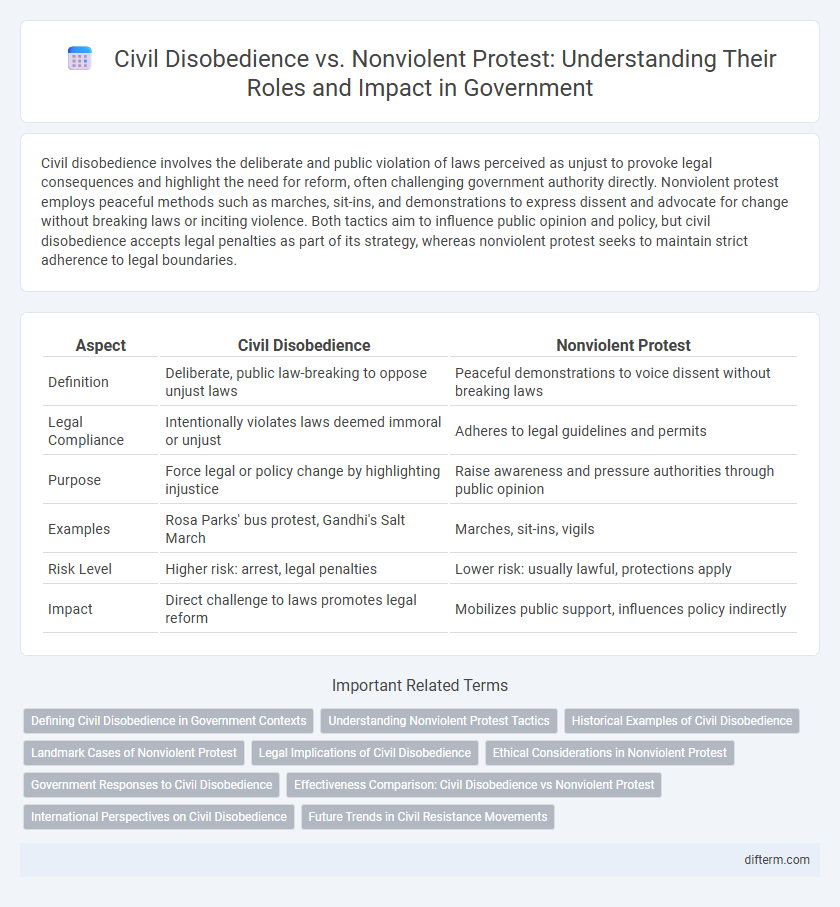Civil disobedience involves the deliberate and public violation of laws perceived as unjust to provoke legal consequences and highlight the need for reform, often challenging government authority directly. Nonviolent protest employs peaceful methods such as marches, sit-ins, and demonstrations to express dissent and advocate for change without breaking laws or inciting violence. Both tactics aim to influence public opinion and policy, but civil disobedience accepts legal penalties as part of its strategy, whereas nonviolent protest seeks to maintain strict adherence to legal boundaries.
Table of Comparison
| Aspect | Civil Disobedience | Nonviolent Protest |
|---|---|---|
| Definition | Deliberate, public law-breaking to oppose unjust laws | Peaceful demonstrations to voice dissent without breaking laws |
| Legal Compliance | Intentionally violates laws deemed immoral or unjust | Adheres to legal guidelines and permits |
| Purpose | Force legal or policy change by highlighting injustice | Raise awareness and pressure authorities through public opinion |
| Examples | Rosa Parks' bus protest, Gandhi's Salt March | Marches, sit-ins, vigils |
| Risk Level | Higher risk: arrest, legal penalties | Lower risk: usually lawful, protections apply |
| Impact | Direct challenge to laws promotes legal reform | Mobilizes public support, influences policy indirectly |
Defining Civil Disobedience in Government Contexts
Civil disobedience in government contexts refers to the intentional, public refusal to obey certain laws or regulations considered unjust, aiming to provoke legal or social change without resorting to violence. It challenges governmental authority by highlighting perceived moral or ethical failures within legislative or executive actions. This form of protest often seeks to raise awareness, influence public opinion, and pressure policymakers to amend or repeal controversial laws.
Understanding Nonviolent Protest Tactics
Nonviolent protest tactics include methods such as sit-ins, marches, boycotts, and civil disobedience, which deliberately avoid physical violence to effect social or political change. These tactics rely on moral authority, public sympathy, and media attention to challenge unjust laws or policies while maintaining peaceful discipline among participants. Prominent historical examples include the Civil Rights Movement led by Martin Luther King Jr., which demonstrated the power of strategic nonviolent resistance to influence government legislation and public opinion.
Historical Examples of Civil Disobedience
Civil disobedience, characterized by the deliberate violation of laws to challenge injustice, has shaped pivotal moments in history such as the 1930 Salt March led by Mahatma Gandhi against British colonial rule in India and the 1955 Montgomery Bus Boycott initiated by Rosa Parks to combat racial segregation in the United States. These acts exemplified strategic resistance that sought to undermine unjust systems through peaceful defiance, contrasting with broader nonviolent protests that may adhere strictly to legal boundaries while advocating for social change. The legacy of civil disobedience in government is reflected in landmark policy reforms and the advancement of civil rights, underscoring its enduring impact on democratic societies.
Landmark Cases of Nonviolent Protest
Landmark cases of nonviolent protest, such as the Montgomery Bus Boycott (1955-1956) led by Rosa Parks and Martin Luther King Jr., showcase the power of civil disobedience in challenging segregation laws. The Greensboro Sit-ins (1960) at a Woolworth's lunch counter further exemplify peaceful resistance against racial discrimination, sparking nationwide movements. These cases demonstrate how strategic nonviolent actions can effectively influence government policies and advance civil rights.
Legal Implications of Civil Disobedience
Civil disobedience involves the intentional violation of laws to challenge government policies, often resulting in legal consequences such as arrest, fines, or imprisonment. In contrast, nonviolent protest typically operates within legal frameworks, emphasizing lawful assembly and expression without breaking statutes. Understanding the legal implications of civil disobedience is critical for activists and policymakers in balancing moral objectives with the rule of law.
Ethical Considerations in Nonviolent Protest
Nonviolent protest upholds ethical principles by prioritizing respect for human dignity and minimizing harm to all stakeholders, including authorities and fellow citizens. It fosters moral legitimacy through adherence to peaceful tactics, which strengthens public support and pressure for policy change without inciting violence or social unrest. Ethical considerations emphasize accountability, transparency, and the commitment to justice while navigating legal boundaries and expressing dissent effectively.
Government Responses to Civil Disobedience
Government responses to civil disobedience typically include legal enforcement measures such as arrests, fines, and imprisonment to maintain public order and uphold laws. Authorities may also implement crowd control tactics, including the deployment of police forces and use of barriers, to manage demonstrations and prevent escalation. In some cases, governments engage in dialogue or policy reforms to address underlying grievances, balancing enforcement with efforts to reduce social tensions and promote stability.
Effectiveness Comparison: Civil Disobedience vs Nonviolent Protest
Civil disobedience often yields more immediate legal and policy changes due to its deliberate law-breaking tactics that attract significant public and governmental attention. Nonviolent protest, while slower to induce direct policy shifts, builds sustained public support and moral authority, influencing long-term social and political transformations. Studies indicate civil disobedience campaigns, such as the Civil Rights Movement, prompted faster legislative responses, whereas nonviolent protests excel in maintaining prolonged societal engagement.
International Perspectives on Civil Disobedience
International perspectives on civil disobedience vary widely, with some governments viewing it as a legitimate form of political expression while others classify it as illegal resistance. Civil disobedience often challenges state authority by knowingly breaking specific laws to highlight injustice, a tactic recognized and sometimes protected under international human rights frameworks such as the Universal Declaration of Human Rights. Nonviolent protest, closely related but less confrontational legally, is frequently endorsed globally as a safer means to demand social or political change without directly violating statutes.
Future Trends in Civil Resistance Movements
Civil resistance movements increasingly leverage digital platforms and AI-driven analytics to coordinate nonviolent protests, enhancing real-time response and global solidarity. Future trends indicate a shift toward hybrid tactics combining traditional civil disobedience with virtual activism to evade surveillance and repression. Governments and activists alike must adapt to evolving technologies that reshape the landscape of civil resistance and political engagement.
Civil Disobedience vs Nonviolent Protest Infographic

 difterm.com
difterm.com